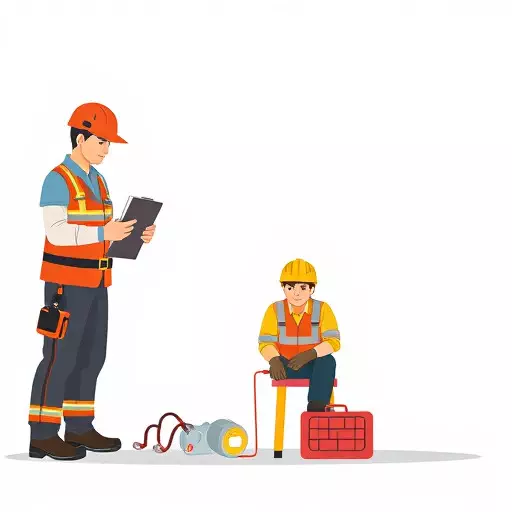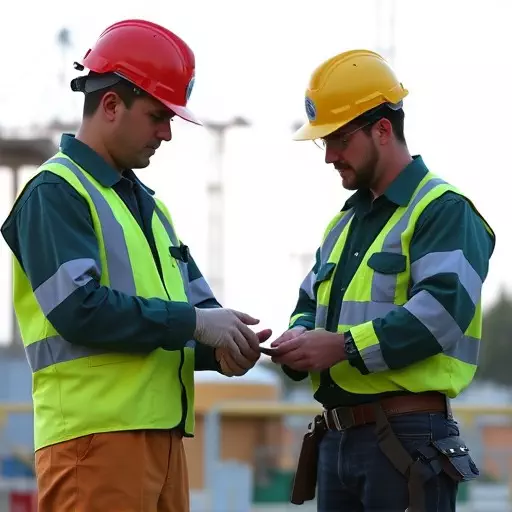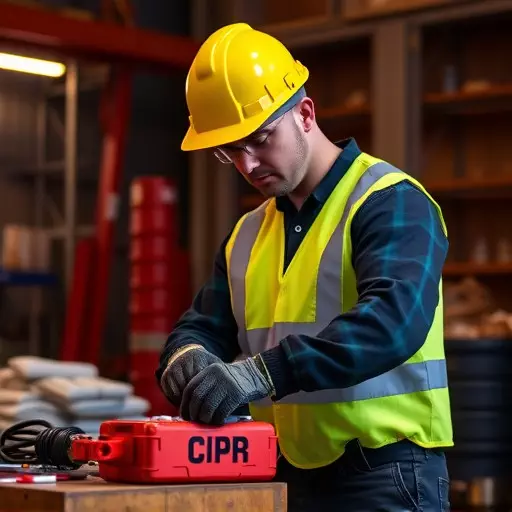Heat stroke is a significant risk for construction workers in hot weather, requiring swift action. OSHA mandates CPR training as essential first aid for construction sites, emphasizing the need for quick response times. Workers must recognize symptoms like high body temperature and dizziness, and be certified in cardiopulmonary resuscitation (CPR) to save lives until professional help arrives. Regular interactive CPR sessions, including pediatric scenarios, are crucial for workers' confidence and survival rates on bustling, high-risk construction sites.
“In the harsh conditions of a construction site, understanding heat stroke—a severe medical emergency—is crucial. This comprehensive guide delves into the first aid basics essential for construction workers, with a focus on CPR techniques. We explore the role of CPR in treating heat stroke, breaking down OSHA guidelines for CPR certification, and providing hands-on training tips tailored to construction site emergencies. Additionally, we emphasize the importance of continuous education for updating skills and staying prepared.”
- Understanding Heat Stroke: Symptoms and Risks for Construction Workers
- The Role of CPR in Heat Stroke Treatment: A Lifesaving Skill
- OSHA Guidelines for CPR Certification: What Construction Workers Need to Know
- Hands-on Training: Effective CPR Techniques for Construction Site Emergencies
- Continuous Education: Updating Skills and Staying Prepared for Unforeseen Incidents
Understanding Heat Stroke: Symptoms and Risks for Construction Workers

Heat stroke is a serious and often deadly condition that can affect construction workers, especially during hot weather conditions. Understanding its symptoms and risks is crucial for those in this industry. The key signs include high body temperature (above 105°F), dry skin with no sweat, rapid breathing or pulse, dizziness, confusion, and loss of consciousness. It’s a medical emergency that requires immediate attention, making CPR training for construction workers essential.
Construction sites have specific OSHA requirements for first aid basics, including cardiopulmonary resuscitation (CPR) certification. These regulations ensure that workers are equipped to handle emergencies like heat stroke until professional medical help arrives. Regular CPR training sessions can make a significant difference in outcomes, as prompt action can save lives.
The Role of CPR in Heat Stroke Treatment: A Lifesaving Skill

In the intense heat of a construction site, every second counts when addressing a heat stroke incident. Cardiopulmonary Resuscitation (CPR) plays an indispensable role in saving lives and managing such emergencies. For construction workers, who frequently face high-temperature environments, acquiring CPR training for construction workers is not just recommended; it’s a critical component of their safety arsenal. Understanding first aid basics for construction workers, including the application of CPR, can make the difference between life and death when faced with a heat stroke victim.
OSHA requirements for CPR certification underscore its importance in industrial settings. Employers are mandated to ensure that employees receive adequate training in emergency response protocols, including CPR. This skill set equips workers to handle critical situations, especially considering the unique challenges posed by extreme heat conditions. Proper CPR administration can help restore circulation and maintain vital organ function until advanced medical help arrives, significantly increasing the chances of a positive outcome for the victim.
OSHA Guidelines for CPR Certification: What Construction Workers Need to Know

Construction workers often face unique challenges on the job, and being equipped with proper first aid knowledge is essential for managing emergencies like heat stroke incidents. The Occupational Safety and Health Administration (OSHA) provides clear guidelines regarding CPR training for construction workers, ensuring they are prepared to respond effectively in critical situations. These OSHA requirements for CPR certification aim to enhance workplace safety and enable workers to provide immediate assistance until professional medical help arrives.
CPR training specifically focuses on the first aid basics crucial for addressing heat stroke cases. Construction workers should understand the indicators of heat stroke, such as dizziness, nausea, headaches, and rapid heartbeat. The OSHA-mandated CPR certification teaches workers how to recognize these signs, perform rescue breathing, and administer chest compressions at a rate of 100–120 compressions per minute. This hands-on training equips them with the skills needed to save lives on construction sites, where heat stroke can be a serious risk due to intense outdoor work conditions.
Hands-on Training: Effective CPR Techniques for Construction Site Emergencies

For construction workers, hands-on training in CPR techniques is crucial due to the unique challenges posed by their high-risk work environments. Regular and realistic simulations are essential in preparing them for heat stroke incidents on site. OSHA (Occupational Safety and Health Administration) requirements mandate that employers provide first aid basics training, including CPR certification, to all workers. This ensures a swift response during emergencies, potentially saving lives.
Effective CPR training for construction workers should cover both adult and pediatric scenarios, as well as the use of AEDs (Automated External Defibrillators). The training must be interactive, emphasizing practical skills rather than just theory. This includes practicing chest compressions at the right rate and depth, proper airway management, and the administration of rescue breaths. Such hands-on preparation allows workers to react confidently in real-life situations.
Continuous Education: Updating Skills and Staying Prepared for Unforeseen Incidents

Continuous education is a vital component in ensuring that construction workers are prepared to handle heat stroke incidents effectively. The rapid evolution of medical practices and protocols demands that first aid skills stay current. Regular updates through advanced CPR training for construction workers can significantly enhance their ability to respond swiftly and accurately during emergencies. This continuous learning process not only keeps their skills sharp but also aligns them with the latest guidelines set by organizations like OSHA, which outlines specific requirements for CPR certification renewal.
Staying prepared involves more than just attending periodic refresher courses. Construction sites present unique challenges due to their dynamic nature and exposure to extreme temperatures. Construction workers should be adept at recognizing heat stroke symptoms early on, as this can significantly improve patient outcomes. By engaging in ongoing professional development, they can acquire advanced first aid basics for construction workers tailored to address the specific needs of their industry, ensuring that they are well-equipped to handle unforeseen incidents with confidence and competence.


